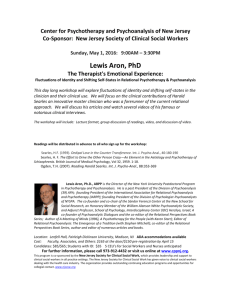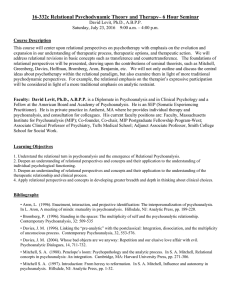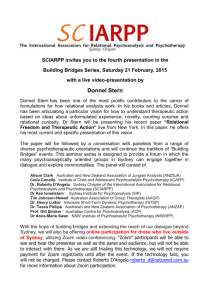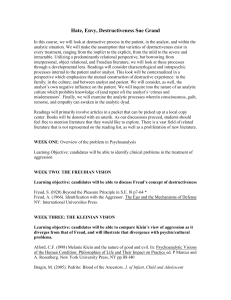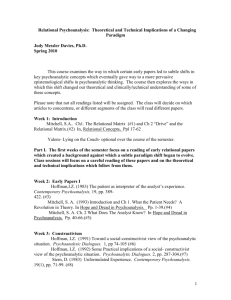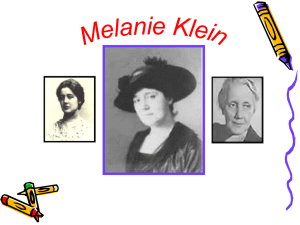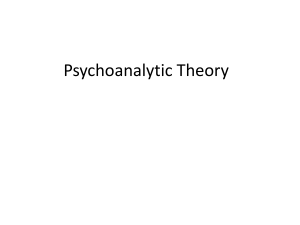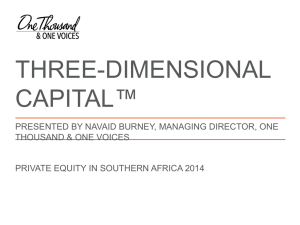Prof. Carlo Strenger, Ph.D. School of Psychological Sciences Cohn
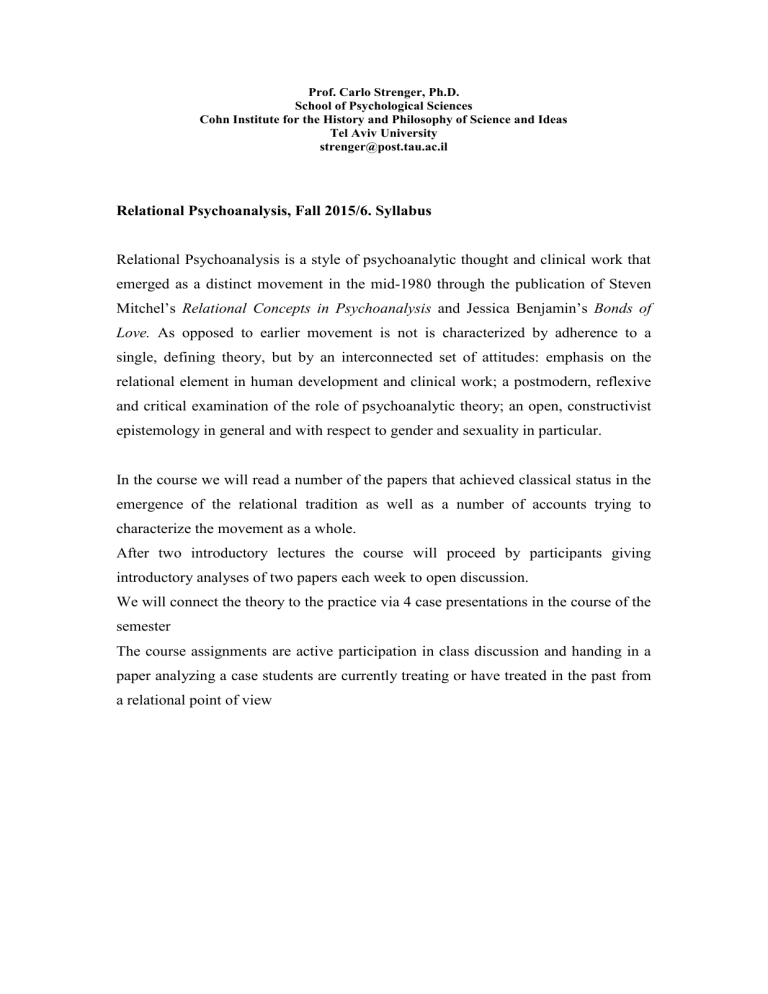
Prof. Carlo Strenger, Ph.D.
School of Psychological Sciences
Cohn Institute for the History and Philosophy of Science and Ideas
Tel Aviv University strenger@post.tau.ac.il
Relational Psychoanalysis, Fall 2015/6. Syllabus
Relational Psychoanalysis is a style of psychoanalytic thought and clinical work that emerged as a distinct movement in the mid-1980 through the publication of Steven
Mitchel’s
Relational Concepts in Psychoanalysis and Jessica Benjamin’s Bonds of
Love. As opposed to earlier movement is not is characterized by adherence to a single, defining theory, but by an interconnected set of attitudes: emphasis on the relational element in human development and clinical work; a postmodern, reflexive and critical examination of the role of psychoanalytic theory; an open, constructivist epistemology in general and with respect to gender and sexuality in particular.
In the course we will read a number of the papers that achieved classical status in the emergence of the relational tradition as well as a number of accounts trying to characterize the movement as a whole.
After two introductory lectures the course will proceed by participants giving introductory analyses of two papers each week to open discussion.
We will connect the theory to the practice via 4 case presentations in the course of the semester
The course assignments are active participation in class discussion and handing in a paper analyzing a case students are currently treating or have treated in the past from a relational point of view
Readings:
General Recommended Introductions
(All three books are available in Hebrew Translation and contain most of the material that will be read in class)
*Stephen Mitchell (1993), Hope and Dread in Psychoanalysis
**Mitchell, S. and Aron, L. (1999) Relational Psychoanalysis: the Emergence of a
Tradition
***Lewis Aron (1996), A Meeting of Minds.
Course Readings
Lecture 2
Lewis Aron (1996), A Meeting of Minds, Chapter 1, The relational Orientation, an
Introduction
I) A New paradigm
Lecture 3: A new Theory?
Lewis Aron (1996), Chapter 2: Relational Theory and its Boundaries, One person and
Two Person Psychologies
Stephen Mitchell (1993), Hope and Dread in Psychoanalysis Chapter 1: What does the Patient Need? A Revolution in Theory
Lecture 4: What does the Analyst know?
Stephen Mitchell (1993), Hope and Dread in Psychoanalysis chapter 2, What does the Analyst know? A Revolution in Metatheory
Mitchell, S. (1993), Hope and Dread in Psychoanalysis chapter 3, The Two
Revolutions together
Lecture 5: Case Presentation by one of the participants
II) Relational views of psychoanalytic Treatment
Lecture 6: What happens in Psychoanalytic Treatment?
Lewis Aron (1996), Chapter 3, The Patient’s Experience of the Analyst’s Subjectivity
Thomas Ogden (1994), The Analytic Third: Working with Intersubjective Clinical
Facts
Jessica Benjamin (1990), Recognition and Destruction: an Outline of
Intersubjectivity.
II) The Analyst’s Subjectivity in the Clinical Process
Lecture 7
Lewis Aron (1996), Chapter 3 The patient’s experience of the analyst’s subjectivity
Irwin Z. Hoffman, (1982) The patient as interpreter of the analyst’s experience
Lecture 8: Case Presentation by Participant
Lecture 9
Lewis Aron (1996) Chapter 4, Interpretation as the Expression of the Analyst’s subjectivity
Carlo Strenger 2005, The Designed Self, Chapter 5
Lecture 10: Mutuality in analytic Treatment
Lewis Aron (1996), Chapter 5, Aspects of Mutuality in Clinical Psychoanalysis
Lewis Aron (1996), Chapter 6: The Dialectics of Mutuality and Autonomy: Ferenczi and Rank.
III) Gender and Sexuality
Lecture 11: How Normal is “Normal” Sexuality?
Nancy Chodorow (1994), Femininities, Masculinities, Sexualities: Freud and Beyond.
Lecture 12: Gender as Compromise
** Adrienne Harris (1991), Gender as Contradiction
Jessica Benjamin (1988), The Bonds of Love: Psychoanalysis, Feminism and the
Problem of Domination. Chapter 2: Master and Slave
Lecture 13: Case Presentation by Participant
Lecture 14: Spirituality in Relational Psychoanalysis. What is Psychoanalytic
Faith?
**Michael Eigen (1981), The Area of Faith in Winnicott, Bion and Lacan.
